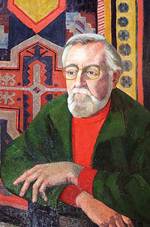Obituary: Tristram Ogilvie Cary, OAM
Born: 14 May 1925, Oxford
Died: 24 April 2008, Adelaide  Obituary Obituary
The death of Dr Tristram Cary was a sad event that resonated within hours throughout the musical world, not only in Australia but around the globe, particularly across North America, continental Europe and the United Kingdom (as the scores of obituary appreciations have testified). Tristram Cary first visited Australia in 1973 and was appointed to a Senior Lecturership in the Elder Conservatorium of Music at the University of Adelaide in 1974. He was then in his late 40s and had already achieved prominence in the United Kingdom and internationally for his achievements in several fields: as the composer of numerous film scores (some of them classics); as the composer of prizewinning works for radio drama; as a composer for the emerging field of television (including his contributions to the iconic Doctor Who series); as one of the pioneering European composers of electronic and electro-acoustic music; and as the designer of a contemporary 'classic' piece of electronic equipment, the VCS3 'Putney' synthesiser. Success in one or two of these fields would have been enough to secure his reputation. Success in all of them was then - and remains today - truly remarkable. Not content to rest on his laurels, Cary decided to make the momentous move to Australia so that he could focus on the composition of concert works. He reasoned that the relative security of an academic salary (as opposed to the precarious, high-wire balancing act of his freelance career) would provide him with the thinking space and creative independence to build a body of concert works. He did just this. During the second half of his life he produced major works including: Contours and Densities at First Hill, for orchestra (the John Bishop Memorial Commission for 1976); Scenes From a Life, for orchestra (a Symphony Australia commission for 2000, to mark his 75th birthday); String Quartet no.2 (1985); I Am Here (1980), for the pre-eminent singer of contemporary works, Jane Manning; and many others. Although there were many positive consequences of his move to Australia (both for him and for the Elder Conservatorium of Music) there were also some professional disappointments that stemmed from the inevitable sense of dislocation. Not without justification he felt overlooked by the musical establishment in the United Kingdom (such as commissioning agencies, orchestras, and the BBC); he was no longer visible on their radar screen. On the other hand, the recognition afforded to him in Australia did not fully reflect the depth and breadth of his professional achievements prior to 1974. He was born in Oxford on 14 May 1925 the third child of the novelist Joyce Cary and Gertrude Margaret Cary (neť Ogilvie). Thanks to his father the family home was frequented by many of the leading literary figures of the day. After attending the Dragon School in Oxford, he went to Westminster School as a King's Scholar, and was then commissioned into the Royal Navy in 1943. During his active war service he specialised in radar communications and received training in electronic engineering. It was this experience that enabled him to become one of the great post-war pioneers in the brand new field of so-called electronic music. On his discharge from the navy in 1946 he went up to Oxford (taking up a deferred place as an Exhibitioner at Christ Church) where he read Literae Humaniores ('Greats'). After graduating from Oxford with his accelerated 'returned serviceman's degree' he studied composition and performance at Trinity College of Music in London and quickly found himself drawn in to the then highly active British film industry. Over the next few years he composed the music for dozens of films, including Ealing Studios classics such as The Ladykillers (1955). In 1998 his new orchestral suite based on the earlier film score was honoured with The Gramophone Award (for best film music on CD). In parallel with his work for films, he became a prolific composer of incidental music for radio and television. Whereas his film music was of necessity stylistically conventional, his music for the other media was ground-breaking, both conceptually and technically. At a time when there was no institutionally financed electronic studio in the UK (unlike Germany, Italy and the USA) he built his own. In recent years he had been putting up a brave fight against cancer. Although this long struggle left him looking frail his personality shone through with an admirably feisty defiance and earthy humour that seemed to help him transcend the suffering. My many personal recollections of Tristram Cary range from 1973 (when we first met, at a concert of his music in London), to the occasion in Bonython Hall in December 2001 when, as the newly installed Elder Professor of Music, I had the privilege and pleasure of presenting him (somewhat belatedly) for the degree of Doctor of Music. Contributed by Professor Charles Bodman Rae
|





